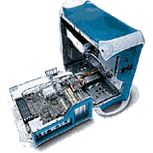Computing News
Apple’s second generation G3s

On January 5, 1999, Apple Computer introduced the second generation of G3 minitower systems (otherwise known as the "blue" G3s because of their new coloration). These systems are probably the most significant technological advance for Apple since the original Power PCs in 1994. They include FireWire, Universal Serial Bus (USB), and an advanced industrial case design with extreme ease of access to the motherboard.
What they have
- 100 MHz system and 66 MHz PCI bus
- 4 SDRAM slots, allowing up to 1 GB of RAM
- 10/100BaseT Ethernet
- Two 12 Mbps USB ports for connecting low-speed devices
- Two 400 Mbps FireWire ports for connecting high-speed devices
- ADB port
- 3 PCI slots
- A standard ATI 3D Rage 128 card that provides video in a 66 MHz/32bit graphics slot with 16 MB SGRAM and a VGA connector on the card
- Mac OS 8.5.1, a USB keyboard, and a USB mouse
What they don’t have
- Serial ports (all printing is now handled through USB or Ethernet, which will require USB-to-serial converters in some cases)
- Standard SCSI (SCSI is available on a PCI card and is included with configurations that include a SCSI hard drive)
- Floppy drive (an internal Zip drive is optional and external USB floppy drives such as the Imation SuperDisk are available)
Standard configurations
The four standard configurations, available at the Computer Connection in February, are:
- Power Macintosh G3 MT (300 MHz/512 KB backside L2 cache/64 MB RAM/6 GB EIDE hard drive/24x CD-ROM)
- Power Macintosh G3 MT (350 MHz/1MB backside L2 cache/64 MB RAM/6GB EIDE hard drive/5x DVD-ROM)
- Power Macintosh G3 MT (350 MHz/1MB backside L2 cache/128 MB RAM/12 GB EIDE hard drive/24x CD-ROM/Iomega ZIP 100 MB drive)
- Power Macintosh G3 MT (400 MHz/1MB backside L2 cache/128 MB RAM/9 GB Ultra SCSI hard drive/24x CD-ROM)
Technical issues & recommendations
ISC does not expect there to be significant hardware-related compatibility problems with the G3 minitower. However, the G3 minitower will have the same software-related conflicts that any Mac OS 8.5.x workstation would have, most notably the conflict with Network Associates Virex 5.9, the University’s supported antivirus software.
ISC has begun testing these workstations for compatibility with University supported hardware and software. Special attention will be paid to dial-up networking and modem functionality, which will be tested using ISC’s modem testing script.
These workstations meet all of ISC’s desktop recommendations for Macintoshes. Of the standard configurations, configuration 3 is a good general desktop choice, with excellent speed, plenty of RAM, and an internal Zip 100 MB drive. As always, support providers should be aware of the technical issues associated with any new workstation design.
--John Mulhern III, Senior IT Support Specialist, ISC Provider Desk
[an error occurred while processing this directive]
[an error occurred while processing this directive]